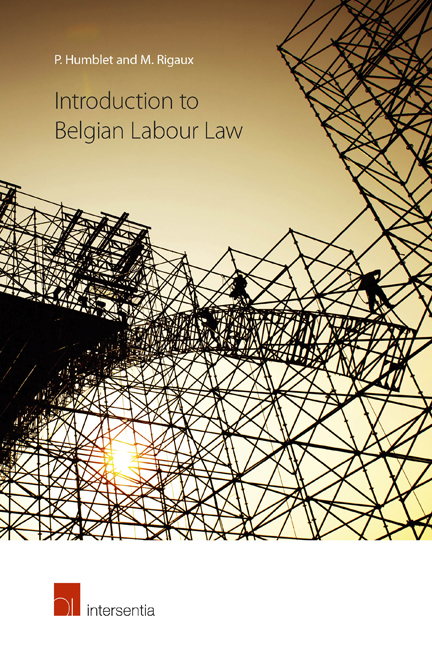Book contents
- Frontmatter
- Preface
- Contents
- List of Abbreviations
- PART I EMPLOYMENT LAW
- I THE CONTRACT OF EMPLOYMENT
- II CONCLUDING THE CONTRACT
- III EMPLOYMENT
- IV TERMINATION OF EMPLOYMENT
- V SPECIAL AND DEVIATING TYPES OF EMPLOYMENT CONTRACTS
- PART II INDUSTRIAL RELATIONS LAW
- I FREEDOM OF ASSOCIATION
- II TRADE UNIONS AND EMPLOYERS’ ASSOCIATIONS
- III INSTRUMENTS FOR SOCIAL DIALOGUE
- IV FUNDS FOR SOCIAL SECURITY
- V INDUSTRIAL ACTION
- Chapter 1 Strikes, Lock-outs and Factory Occupation
- Chapter 2 Settlement of Industrial Conflicts by Mediation and Conciliation
- Chapter 3 Regulations for Settling Industrial Disputes
- Chapter 4 Settlement of Industrial Disputes by the Courts
- In Cauda
- General Bibliography
- E-addresses
Chapter 4 - Settlement of Industrial Disputes by the Courts
from V - INDUSTRIAL ACTION
Published online by Cambridge University Press: 13 December 2017
- Frontmatter
- Preface
- Contents
- List of Abbreviations
- PART I EMPLOYMENT LAW
- I THE CONTRACT OF EMPLOYMENT
- II CONCLUDING THE CONTRACT
- III EMPLOYMENT
- IV TERMINATION OF EMPLOYMENT
- V SPECIAL AND DEVIATING TYPES OF EMPLOYMENT CONTRACTS
- PART II INDUSTRIAL RELATIONS LAW
- I FREEDOM OF ASSOCIATION
- II TRADE UNIONS AND EMPLOYERS’ ASSOCIATIONS
- III INSTRUMENTS FOR SOCIAL DIALOGUE
- IV FUNDS FOR SOCIAL SECURITY
- V INDUSTRIAL ACTION
- Chapter 1 Strikes, Lock-outs and Factory Occupation
- Chapter 2 Settlement of Industrial Conflicts by Mediation and Conciliation
- Chapter 3 Regulations for Settling Industrial Disputes
- Chapter 4 Settlement of Industrial Disputes by the Courts
- In Cauda
- General Bibliography
- E-addresses
Summary
SECTION 1. GENERAL OVERVIEW
Since the mid-1980s, employers have occasionally turned to the courts to seek judicial intervention in industrial disputes. For example, when a plant is blocked by a picket line, the court is asked to forbid this on the grounds of, among other things, the right to work.
The majority of legal scholars believe that it is not incumbent on the judiciary to settle industrial disputes. Such conflicts should be solved through the appropriate channels, for example conciliation bureaus.
As a rule, employers never ask the courts to end an industrial dispute, but to stop certain forms of strike action which are held to violate subjective rights – qualified by some as ‘acts of violence’. Refusal to intervene would constitute a breach of Article 6(1) of the Convention for the Protection of Human Rights and Fundamental Freedoms, and Article 14 of the International Covenant on Civil and Political Rights. Nowadays the courts’ intervention is no longer contested.
SECTION 2. PROCEDURE
The question arises as to which court has jurisdiction. Although labour tribunals would seem the most appropriate, employers usually appeal to courts of first instance. Employers generally apply for a summary procedure by means of ex-parte proceedings. They resort to such action because, unlike in the Netherlands, for example, they cannot prosecute the unions involved in collective action because these have no legal personality and because the identity of the members of the striking pickets is often unknown.
Employers claim damages to ensure that striking pickets follow the opponent's instructions. Amounts vary.
If the court follows the employer's reasoning, the former will order the picketers to end their action.
This order is remitted to a bailiff. The latter takes the writ to the enterprise where the industrial dispute is taking place and serves it on the persons guilty of the alleged offence.
To ensure compliance with the court order, the plaintiff will usually request the police to check the picketers’ identities. Refusal to comply with this request may result in the payment of damages.
- Type
- Chapter
- Information
- Introduction to Belgian Labour Law , pp. 263 - 264Publisher: IntersentiaPrint publication year: 2016

